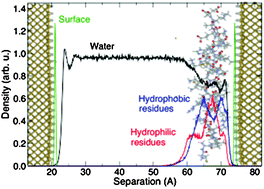Water structuring and collagen adsorption at hydrophilic and hydrophobic silicon surfaces
Abstract
The

* Corresponding authors
a
Theory of Condensed Matter Group, Cavendish Laboratory, University of Cambridge, J J Thomson Avenue, Cambridge, UK
E-mail:
djc56@cam.ac.uk
b
Hybrid Materials Interfaces Group, Faculty of Production Engineering and Bremen Centre for Computational Materials Science, University of Bremen, 28359 Bremen, Germany
E-mail:
colombi@hmi.uni-bremen.de
c Fraunhofer Institut für Fertigungstechnik und Angewandte Materialforschung IFAM, Wiener Str. 12, 28359 Bremen, Germany
The

 Please wait while we load your content...
Something went wrong. Try again?
Please wait while we load your content...
Something went wrong. Try again?
D. J. Cole, M. C. Payne and L. C. Ciacchi, Phys. Chem. Chem. Phys., 2009, 11, 11395 DOI: 10.1039/B816125A
To request permission to reproduce material from this article, please go to the Copyright Clearance Center request page.
If you are an author contributing to an RSC publication, you do not need to request permission provided correct acknowledgement is given.
If you are the author of this article, you do not need to request permission to reproduce figures and diagrams provided correct acknowledgement is given. If you want to reproduce the whole article in a third-party publication (excluding your thesis/dissertation for which permission is not required) please go to the Copyright Clearance Center request page.
Read more about how to correctly acknowledge RSC content.
 Fetching data from CrossRef.
Fetching data from CrossRef.
This may take some time to load.
Loading related content
